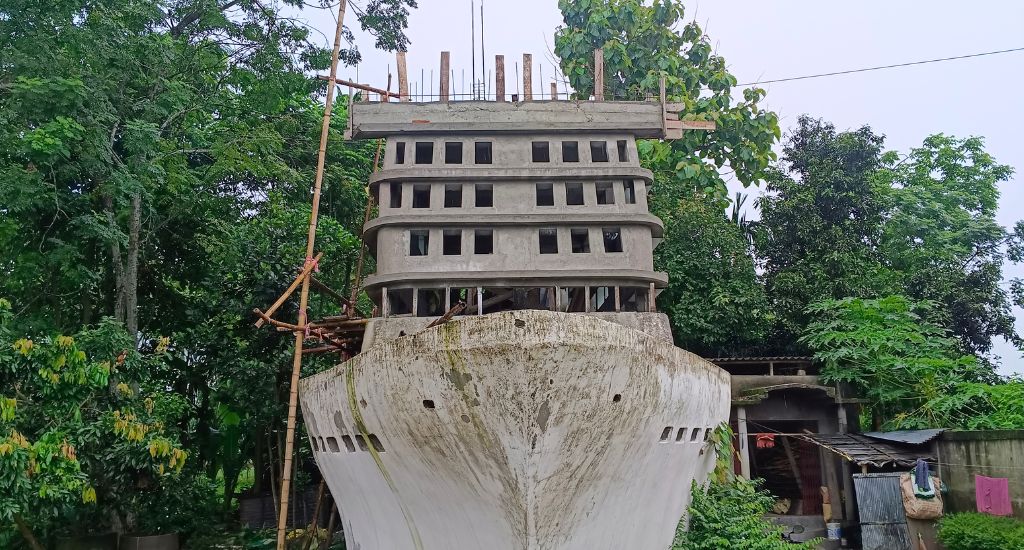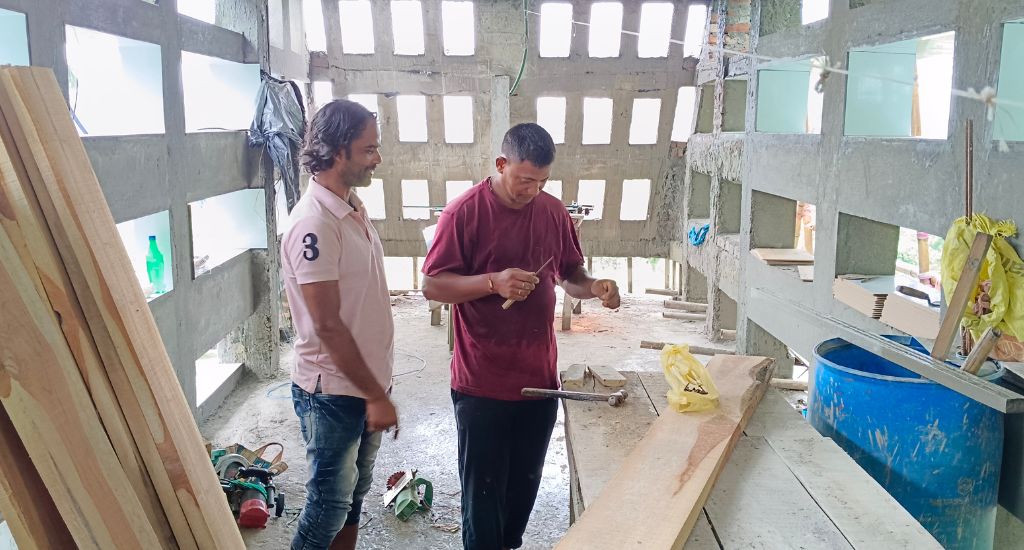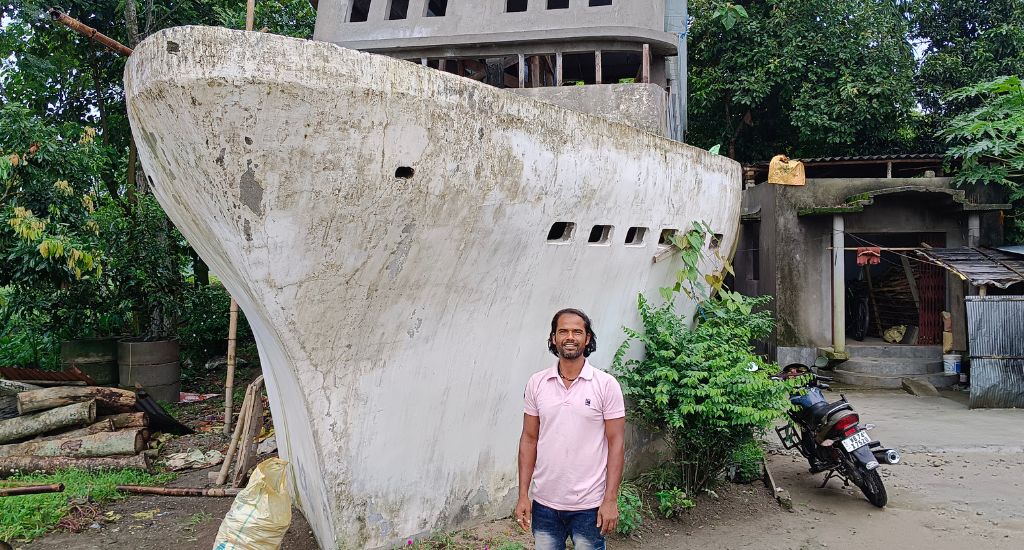
Titanic comes alive as Jahaj Bari in a north Bengal village
A man’s ship-shaped childhood dream takes concrete form in the small village of Nijbari, nestled in the heart of West Bengal’s Darjeeling district.

A man’s ship-shaped childhood dream takes concrete form in the small village of Nijbari, nestled in the heart of West Bengal’s Darjeeling district.
Far away from its watery grave in the Atlantic, the Titanic is a rare example of unusual architecture in a north Bengal village, which otherwise abounds with a picturesque landscape dotted with single-storey houses, patches of trees and paddy fields.
What is it? A vanity project? A light-headed lunacy that wanted to push the boundaries of design and spawn a far-out shape? Or, is it simply a man’s childhood fascination for the sunken ship that shaped a living house of brick, mortar and rebar, rather than striving for strangeness for its own sake?
In the small village of Nijbari, nestled in the heart of Darjeeling district, 43-year-old Mintu Roy has transformed his childhood dream into a spectacular reality, defying severe financial constraints. He has become a shining example of the power of dreams and the unwavering determination required to fulfil them.
Mintu earns his livelihood by driving an e-rickshaw and growing crops. However, his humble jobs did not deter him from pursuing his grand vision of constructing a house modelled after the legendary Titanic, the colossal vessel that met its tragic fate in the icy waters of the North Atlantic on April 14, 1912. Despite over a century passing since that fateful event, the Titanic continues to captivate hearts and minds, thanks in part to James Cameron’s iconic 1997 movie.
Mintu’s fascination with the Titanic began in 1995 when he was a seventh-grade student in Kolkata. During the grand celebration of Durga Puja, Bengal’s biggest carnival, he encountered a pandal inspired by the majestic ship.
Also Read | Bengal’s farmers are behind Kolkata’s stunning Durga Puja pandals

The sight left an indelible impression on him, sparking a childhood fantasy that he would one day construct his own Titanic-shaped abode. The dream only grew stronger after he watched the movie, further fuelling his desire to turn his vision into reality.
Returning to his father in north Bengal, Mintu embarked on a journey of assisting him in farming. Yet, day after day, his dreams of a Titanic house persisted. In 2012, he finally mustered the courage to share his grand plan with his father.
The response was initially one of anger and disbelief. Mintu’s father believed it to be a frivolous waste of time and money, and even the neighbours found the idea ludicrous, mocking his ambitious aspiration.
Undeterred, Mintu was determined to pursue his dream. With the earnings of Rs 2 lakh from a successful cauliflower crop that year, he decided to invest in the construction of his Titanic house.
However, finding masons with the necessary skills proved to be a daunting task. The local craftsmen were unfamiliar with the intricacies of building such a unique structure, having neither heard of nor seen the Titanic.
Mintu’s determination knew no bounds. Unfazed by the challenges, he resolved to learn the art of masonry himself. Crossing the porous border to Nepal, a mere 12km from his village, Mintu embarked on a journey of self-improvement.

Nepal offered better wages and provisions for labourers, unlike his village. He dedicated 18 months to honing his masonry skills.
Though lacking any formal training in architecture, Mintu poured his heart and soul into every detail of the construction process. The ship’s design, meticulously crafted in his mind, was brought to life by his own hands.
His earnings as an e-rickshaw driver supplemented his family income, ensuring that the money from farming could be dedicated to the realisation of his extraordinary house. Over the course of a decade, he invested around Rs 15 lakh, and today, 75 per cent of the house stands complete, bearing a striking resemblance to the grand vessel.
With the ground floor already inhabited by Mintu and his family, the two-storey structure boasts four gates resembling ship entrances and features the Titanic’s signature, rectangular port holes in place of conventional windows. The first floor serves as the ship’s deck, complete with a captain’s room, and Mintu plans to open a restaurant there to attract tourists and generate additional income.
Mintu’s architectural curiosity initially caused some controversy, but that gradually disappeared and the building became a visual treat for those seeking to admire unique things. Dubbed the “Jahaj Bari” or ship house, it has become a popular selfie point, drawing admirers from far and wide.

Those who once ridiculed Mintu now sing his praises. Sukev Mondal, a villager, expressed his pride: “He has made us proud by building the house, and our village has gained significant media attention and recognition. People now associate our village with the Jahaj Bari.”
Mintu’s awe-inspiring achievement serves as a testament to the limitless potential of the human spirit. In his own words, Mintu offers a powerful message to those who face adversity: “I believe that everybody can achieve their dreams if they work with passion and conviction. Nothing is impossible if we have the courage to pursue our dreams.”
Also Read | Bengal banana farmers bask in sunshine
The lead image shows Mintu Roy’s Titanic ship house (Photo by Gurvinder Singh)
Gurvinder Singh, a journalist based in Kolkata.